When it rains, it pours, leaving your lawns gut-wrenchingly muddy. While it’s acceptable for the bog to last a day or two, the story changes if it overstays its welcome. Unfortunately, there’s no one-size-fits-all solution for soggy lawns; plenty can go wrong with them, necessitating specific remediation. Improper slope gradation, inadequate water percolation, and surface runoff are some common reasons why you may be treading in murky waters. But you can ride them out unblemished by regrading the slope, installing drainage channels, aerating the lawn, amending the soil, and hardscaping the mud-spattered ground.
Muddy lawns are a source of great displeasure to most gardeners, and the loud squelching noises coupled with paw marks inside and outside your home aren’t welcomed either. Flooded yards also weaken the grass, resulting in bare patches soon populated by hardy weeds. It’ll even invite moss, algae, mosquitoes, and liverworts to your yard. Plus, the risk of accumulated water seeping into the foundation of your home is all too real, not to mention expensive to tackle. Considering the host of problems muddy yards can bring, resolving the issue before things go downhill is imperative. But before taking the steps outlined below, inspect your lawn for any leaks in drainage pipes and sprinkler systems, since they might aggravate the situation.
Reroute downspouts or regrade the slope to improve drainage
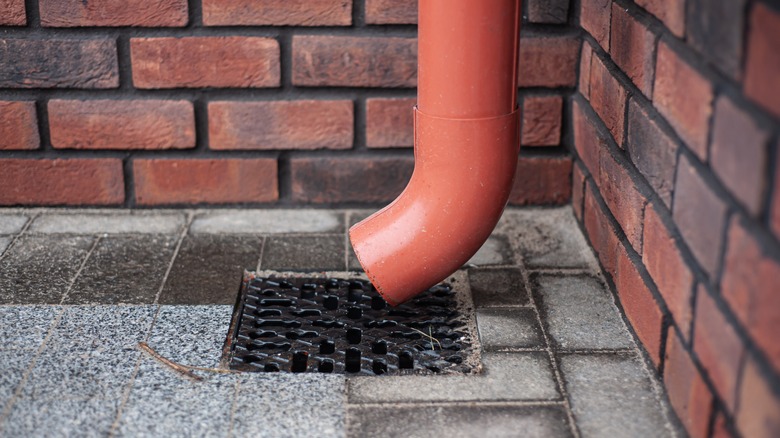
The first step to restoring your lawn’s stately glory is to ensure the drainage system is in tip-top shape. This means ascertaining if the water empties out of the gutters into the drain pipes and not onto your turf. Ensure the downspouts extend at least 6 feet from your home’s foundation — even better if their flow can be rerouted to a pond or a trench outside your property.
Confirming if the lawn slopes downward and away from the foundation helps, too. Intermittent collections of muddy water patches in the lawn, especially mid-way through, are often signs of poor gradation. As a rule, slopes must decline by ¼ inch for every foot of area to avoid water pooling. However, you can correct the situation by picking up the topsoil from the lower end and moving it to the slope’s top. Be cautious, though, as you can’t build the soil beyond the home’s concrete or cinder block structural support, unless you want to invite in termites.
If your lawn is flat and lacking all scope for topping soil at its top end, you might be dealing with “settling soil.” If the soil isn’t backfilled adequately during construction, it’ll hurt its decline and compress it. Under such circumstances, pulling back organic mulch, layering on clay-rich soil in multiple shifts, and tamping it down with a rammer while maintaining a 4% slope decline should help.
Aerate or dethatch your lawn to enhance water infiltration
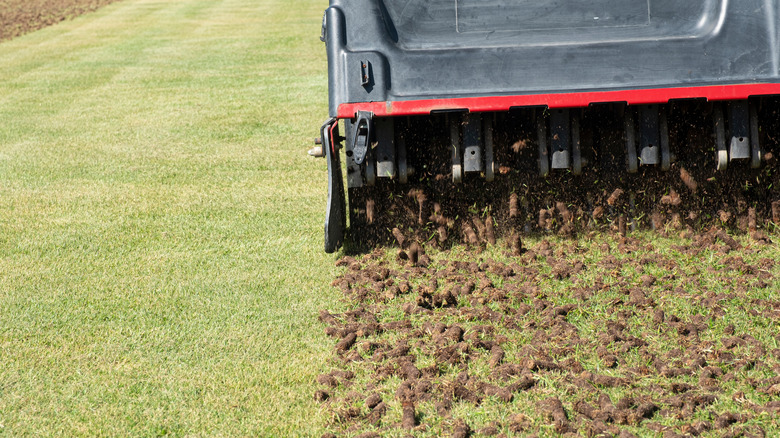
If your drainage system isn’t the source of trouble, look toward your lawn’s water permeation levels. Poor upkeep, overuse of nitrogen fertilizers, growing aggressive grass varieties, and compacted soils often encourage thatch development. Although this organic layer of dead roots, crowns, leaves, and stems increases the lawn’s wear tolerance, it transmutes into its nemesis when it adds over ½ an inch of thickness. Excessive thatch impedes water permeation, giving rise to muddy patches in the lawn. You can remove this layer with a dethatching rake.
As core aerating the lawn involves pulling out plugs of clumping soil, it improves water and oxygen absorption while giving thatch-decomposing microbes a leg up. This ensures water doesn’t puddle, preventing your yard from becoming soggy. However, put aeration off until the soil slightly dries (or is just moist) and follow up with fertilization or overseeding after giving the lawn a few passes. Pitchforks suffice for aeration in small lawns, but powered aerators are more efficient in bigger areas. Remember, aeration only works in the short term and proves less-than-optimal against impervious, deeper, sub-soil substrates — but when combined with other steps, this may be your yard’s saving grace.
Amend the soil, mulch, or sod hardier grasses to control erosion
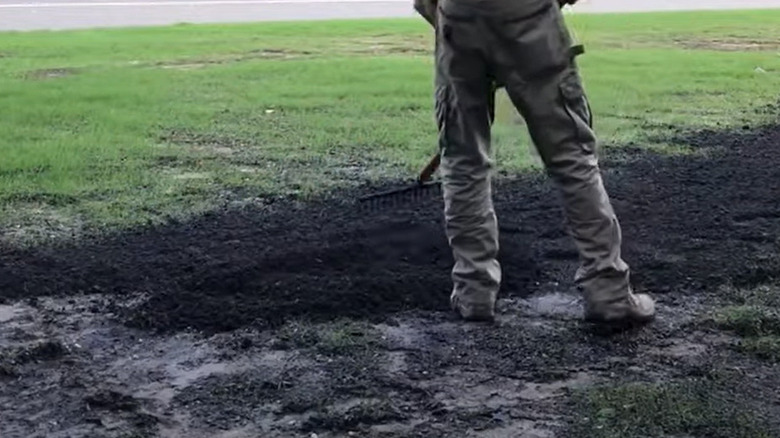
Erik Covington / YouTube
Sometimes, lawns turn muddy because they cannot hold onto stormwater. They could have been mowed too low, which killed the grass and left the soil bare for water to pool. Or maybe you sodded on compacted clay soils that struggle with drainage. To fix these problems, amending the soil with compost can improve the substrate’s water-holding capacity (assuming the water tables aren’t high). But working them in requires upending the lawn, so it’s best left for when you resod. Also, base the amendments on a soil test.
Alternatively, you can top-dress the soil with biodegradable materials like coconut coir, burlap, or jute to minimize surface runoff. Organic mulches, such as coarse wood chips, pine straws, and hay, are other worthy options. But don’t spread them too thick — between 2 and 4 inches is optimum. Otherwise, the grasses may root shallowly.
Some gardeners prefer inorganic mulches like gravel, as their organic counterparts break down over time, requiring frequent reapplication. Besides, they’re less likely to run off under immense water pressure. However, abstain from using plastic nets, as disposing of them is troublesome. Plus, they might get stuck in lawnmowers, assuming you sidestep them during your morning walk. Finally, if the climate allows, plant turf (like bermudagrass) that better stomachs flooding. But if this proves unfruitful, switch to clover, wintercreeper, or silver carpet; they’ll survive your dog’s trudging and peeing, too.
Install interceptor drains or swales
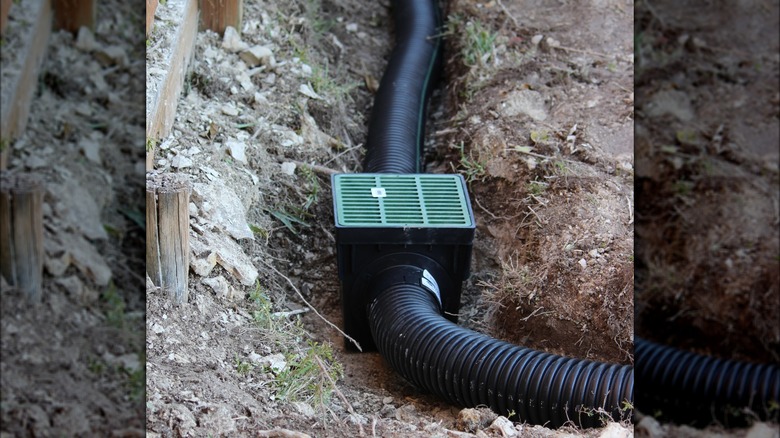
Jasmine Sahin/Shutterstock
If all else fails, install subsurface drainage systems. French drains perform the best on sloped lawns. Essentially, they involve digging a trench along the fence or at the property’s end, lining it with geotextile fabric, and laying down a perforated pipe. Ideally, the pipe should connect to a culvert or a ditch to transport the water offsite. Afterwards, the drain is covered with pea gravel or topsoil, depending on your aesthetics.
Another inexpensive option is to invest in grassy swales or shallow, gradually-declining ditches that collect and slow down the velocity of water and sediment runoff, allowing the water to seep into the soil slowly. They are often also decorated with wetland plants like cattails, sedges, and rushes that prevent the standing water from damaging the grass. However, don’t use them in high-traffic areas, as the compacted soils turn swales into gulleys, worsening the situation. They’re also unsuitable for lawns larger than 5 acres.
Introduce hardscaping into the yard
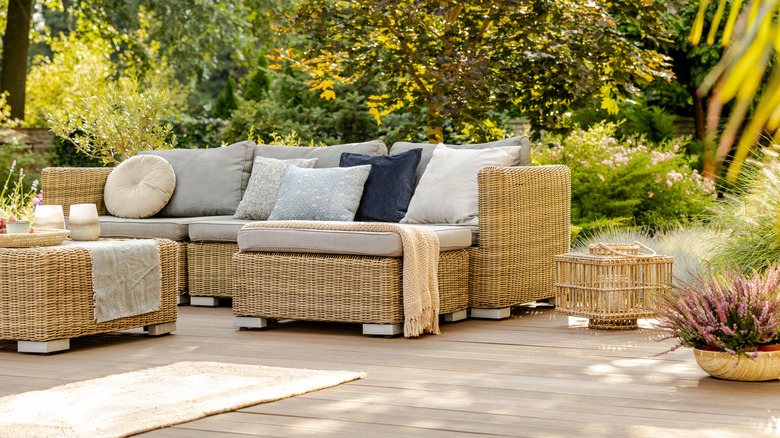
Ground Picture/Shutterstock
Lastly, redesign your landscape by introducing hardscaping elements into your yard like stone paths, patios, decks, walkways, or walls. These can help reclaim marshy areas while adding visual interest and depth to the yard. Materials like gravel, wood chips, rocks, sandstone, or crushed bricks improve water infiltration. Remove any pre-existing vegetation and lay down landscape fabric before spreading the hard layer. This will prevent weeds from taking root. For instance, you can construct a lounge, play zone, or gazebo in particularly-mushy areas. Similarly, if the soddy section lies in the middle of your lawn, cover it with large gravel stones to give off the look of a connecting path around your property.
Avoid using solid concrete since it doesn’t drain well and generally looks unappealing in a yard unless you’re going for an industrial look. It also poses a trip hazard in colder climates when it’s carpeted with snow. Pets find concrete paths uncomfortable to trod on as well because they can become extremely hot in the intense summer heat. Moreover, they cost a pretty penny.




